Do you have a question about the Panasonic NU-SC280W and is the answer not in the manual?
Guidelines for safe cooking practices and product inspection before use.
List of actions, items, and conditions to avoid for safe operation.
Identification of potentially dangerous items and scenarios related to the appliance.
Comprehensive safety advice and operational instructions for users.
Critical information regarding power supply, grounding, and plug usage for safety.
Information about normal operational phenomena, like the electric fan's behavior.
Instructions for positioning the appliance safely and ensuring proper ventilation.
Advice for safe handling of hot foods and liquids during cooking.
Critical warnings about product damage, repair, child supervision, and cleaning.
Explains heating principle and uses for Convection, Ferment, and Healthy Fry modes.
Describes the heating principle and applications for Steam Med and Steam Low modes.
Details the heating principle and uses for Stew and Steam High modes.
Explains the combined steam and convection heating principle and applications.
Essential techniques like timing, spacing, browning, piercing, and repositioning food.
How size, shape, starting temperature, and density affect cooking.
Labeled diagram of the oven's parts, including controls and safety features.
Instructions for installing, removing, and maintaining the water tank and drip tray.
Advice on using trays and selecting shelf positions for various cooking modes.
Overview of the control panel's buttons, display, and dial functions.
Table detailing which cookware types are suitable for various cooking modes.
Important notes regarding accessory usage, safety, and preheating.
Explanation of icons and indicators shown on the display.
Overview of available cooking modes and their corresponding page references.
Meaning of different beep sounds and their relation to cooking stages.
How to use the dial and buttons for setting functions, menus, time, weight, and temperature.
Introduction to Steam High, Steam Med, and Steam Low modes for moist cooking.
Step-by-step guide on how to select steam mode, set time, and start cooking.
List of foods suitable for each steam setting and important notes.
Step-by-step instructions for using the Healthy Fry mode for oil-free cooking.
Guidance on setting and modifying cooking time for the Healthy Fry function.
Details on 30°C and 40°C modes for fermenting bread dough and pastries.
Step-by-step guide for setting temperature, time, and starting the fermentation process.
Important notes regarding temperature effects, error codes, and steam shot usage.
Instructions for using the combined steam and convection heat for slow cooking.
Guide on setting cooking time and other parameters for stewing.
Step-by-step guide for using convection with a preheating cycle.
Instructions for operating the convection function without a preheating phase.
How to set temperature and cooking time for convection cooking.
Guide for combining steam and convection cooking with preheating.
Instructions for using steam convection without a preheating phase.
How to set temperature and cooking time for steam convection.
How to use the Steam Shot function to add steam during Convection or Ferment modes.
Guidance on when to use Steam Shot for baking cakes, bread, and fermentation.
Procedure to activate the child safety lock feature to prevent accidental operation.
Procedure to deactivate the child safety lock feature.
How to select and use auto menus that do not require preheating.
Guide for using auto menus that require a preheating phase.
Step-by-step guide for selecting menu numbers and starting the cooking process.
Recommended times and programs for reheating various foods.
Notes regarding steam, baking paper, and chilled food storage for reheating.
Guidance on cooking various foods using different modes and placements.
Notes on steam, baking paper, and defrosting for cooking.
Introduction to modes for cleaning baby bottles, breast pumps, and dishes.
Step-by-step guide for selecting menu and operating the utensil cleaning function.
Notes on heat resistance, error codes, bottle placement, and quantity limits.
Instructions for using the deodorization function to remove odors from the oven cavity.
Instructions for cleaning oil stains and dirt from the oven cavity.
Notes on filling the water tank and wiping the cavity after cleaning.
How to use the function to drain residual water from steam lines to the drip tray.
Notes on not removing the drip tray and washing it after cleaning.
Steps for cleaning water-piping using citric acid solution.
Instructions for preparing the solution, cleaning, and handling the water tank and drip tray.
Precautions and general advice for cleaning the oven after it has cooled down.
Methods for cleaning the oven's exterior surfaces and interior cavity.
Instructions for cleaning the door, window, control panel, water tank, and drip tray.
Solutions for problems like no display, power issues, and oven not starting.
Solutions for issues related to steam generation, U14, U50 errors, and white powder.
Explanations for normal sounds, steam behavior, fan operation, and minor cosmetic changes.
Details on model number, power, dimensions, capacity, and weight.
Information regarding IEC test procedures and subject to change notices.
Guidelines for safe cooking practices and product inspection before use.
List of actions, items, and conditions to avoid for safe operation.
Identification of potentially dangerous items and scenarios related to the appliance.
Comprehensive safety advice and operational instructions for users.
Critical information regarding power supply, grounding, and plug usage for safety.
Information about normal operational phenomena, like the electric fan's behavior.
Instructions for positioning the appliance safely and ensuring proper ventilation.
Advice for safe handling of hot foods and liquids during cooking.
Critical warnings about product damage, repair, child supervision, and cleaning.
Explains heating principle and uses for Convection, Ferment, and Healthy Fry modes.
Describes the heating principle and applications for Steam Med and Steam Low modes.
Details the heating principle and uses for Stew and Steam High modes.
Explains the combined steam and convection heating principle and applications.
Essential techniques like timing, spacing, browning, piercing, and repositioning food.
How size, shape, starting temperature, and density affect cooking.
Labeled diagram of the oven's parts, including controls and safety features.
Instructions for installing, removing, and maintaining the water tank and drip tray.
Advice on using trays and selecting shelf positions for various cooking modes.
Overview of the control panel's buttons, display, and dial functions.
Table detailing which cookware types are suitable for various cooking modes.
Important notes regarding accessory usage, safety, and preheating.
Explanation of icons and indicators shown on the display.
Overview of available cooking modes and their corresponding page references.
Meaning of different beep sounds and their relation to cooking stages.
How to use the dial and buttons for setting functions, menus, time, weight, and temperature.
Introduction to Steam High, Steam Med, and Steam Low modes for moist cooking.
Step-by-step guide on how to select steam mode, set time, and start cooking.
List of foods suitable for each steam setting and important notes.
Step-by-step instructions for using the Healthy Fry mode for oil-free cooking.
Guidance on setting and modifying cooking time for the Healthy Fry function.
Details on 30°C and 40°C modes for fermenting bread dough and pastries.
Step-by-step guide for setting temperature, time, and starting the fermentation process.
Important notes regarding temperature effects, error codes, and steam shot usage.
Instructions for using the combined steam and convection heat for slow cooking.
Guide on setting cooking time and other parameters for stewing.
Step-by-step guide for using convection with a preheating cycle.
Instructions for operating the convection function without a preheating phase.
How to set temperature and cooking time for convection cooking.
Guide for combining steam and convection cooking with preheating.
Instructions for using steam convection without a preheating phase.
How to set temperature and cooking time for steam convection.
How to use the Steam Shot function to add steam during Convection or Ferment modes.
Guidance on when to use Steam Shot for baking cakes, bread, and fermentation.
Procedure to activate the child safety lock feature to prevent accidental operation.
Procedure to deactivate the child safety lock feature.
How to select and use auto menus that do not require preheating.
Guide for using auto menus that require a preheating phase.
Step-by-step guide for selecting menu numbers and starting the cooking process.
Recommended times and programs for reheating various foods.
Notes regarding steam, baking paper, and chilled food storage for reheating.
Guidance on cooking various foods using different modes and placements.
Notes on steam, baking paper, and defrosting for cooking.
Introduction to modes for cleaning baby bottles, breast pumps, and dishes.
Step-by-step guide for selecting menu and operating the utensil cleaning function.
Notes on heat resistance, error codes, bottle placement, and quantity limits.
Instructions for using the deodorization function to remove odors from the oven cavity.
Instructions for cleaning oil stains and dirt from the oven cavity.
Notes on filling the water tank and wiping the cavity after cleaning.
How to use the function to drain residual water from steam lines to the drip tray.
Notes on not removing the drip tray and washing it after cleaning.
Steps for cleaning water-piping using citric acid solution.
Instructions for preparing the solution, cleaning, and handling the water tank and drip tray.
Precautions and general advice for cleaning the oven after it has cooled down.
Methods for cleaning the oven's exterior surfaces and interior cavity.
Instructions for cleaning the door, window, control panel, water tank, and drip tray.
Solutions for problems like no display, power issues, and oven not starting.
Solutions for issues related to steam generation, U14, U50 errors, and white powder.
Explanations for normal sounds, steam behavior, fan operation, and minor cosmetic changes.
Details on model number, power, dimensions, capacity, and weight.
Information regarding IEC test procedures and subject to change notices.
| Voltage | 220-240V |
|---|---|
| Frequency | 50 Hz |
| Color | White |
| Power | 1000 Watts |
| Water Tank Capacity | 1.2L |
| Cooking Modes | Microwave, Steam, Grill, Combination |
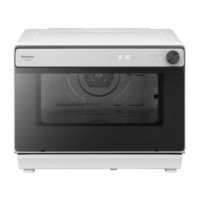
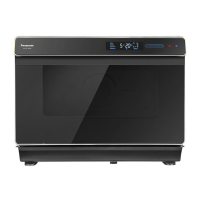
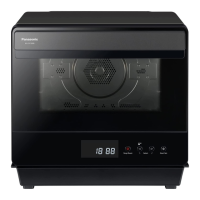
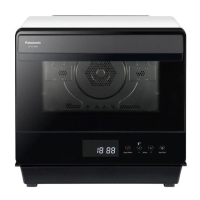
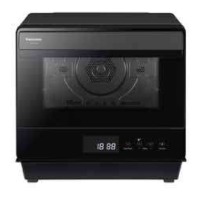
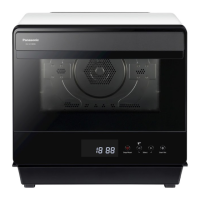
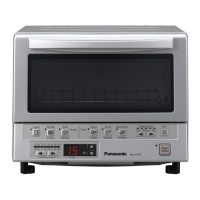
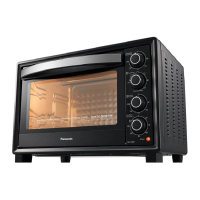
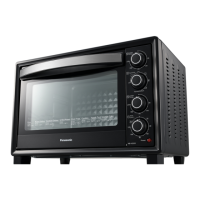
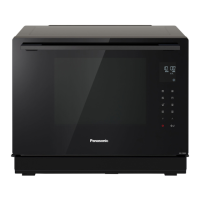
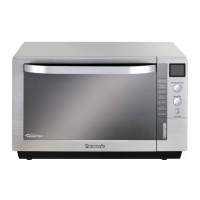
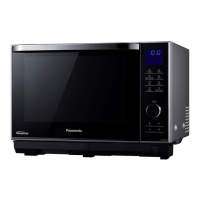
